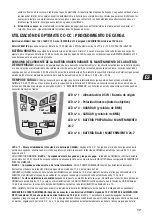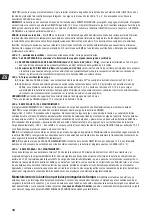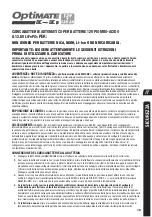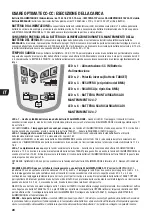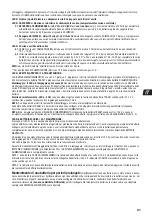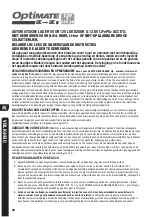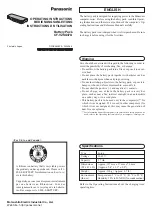
7
System of a Lithium (LiFePO4) battery with built-in deep discharge protection. Charging starts when either LED #3 OR
LED #4 turn on alone. See LED description below.
RE-START :
If a battery is not connected within the 1 minute START UP period the charger shuts off completely. The
charger will re-activate if connected to a TARGET battery measuring 10V or more OR to reset the charger OR
re-activate the BMS reset pulse for a lithium battery: 1) disconnect from SOURCE battery, 2) connect to the TARGET
battery 3) re-connect to the SOURCE BATTERY or DC supply.
ERROR - Lithium batteries only - BMS not resetting
: 1) An advanced battery management system that includes
thermal protection, prevents operation if the battery temperature falls outside of the manufacturer recommended safe
operating temperature range. Check battery manufacturer's specifications. 2) Battery is connected in reverse polarity.
Correct the connections and try again. 3) The circuit connected to the battery is preventing the pulse from being
delivered. Disconnect or turn off the circuit and try again. 4) The battery's BMS may have suffered damage. Have the
battery professionally assessed.
LED #2 REVERSE POLARITY -
wrong output connections. Swap around to activate output.
LED #3 SAVE
lights If the battery is extremely flat (deep-discharged or sulphated), Time: 4 hours.
3.1
LOW VOLT SAVE (from 2V) to 8.8V (
LED #3 steady on
) :
Current is limited to 200mA so that the battery may
gently recover to a safe voltage level of 8.8 Volts. Batteries able to accept 0.2A of charge current will advance to
PULSE recovery.
3.2 PULSE recovery -
LED #3 steady on:
Current up to 2A is delivered in pulses to prepare the battery to
accept normal charge.
LED #4 CHARGE
4.1
CHARGE: The BULK CHARGE stage delivers a constant current of 2A** into the battery, up to a voltage of
14.3V.
4.2 Optimize / Pulsed absorption:
Current is delivered in pulses, varying between 0.2 and 2A** and up to a voltage
of 14.2 - 14.4V, to bring the battery to full charge in the shortest possible time.
Charge time is usually extended
if there is higher than expected current draw by connected circuitry or battery health is less than optimal.
NOTE:
For safety reasons there is an overall charge time limit of 48 hours.
**
For SOURCE voltage below 12V the current will be limited to 1 Amp.
LED #5 BATTERY READY / 24-7 MAINTAIN:
The
24-7 MAINTAIN program cycles between Monitor and Maintenance charge modes to maintain the TARGET
battery at full charge whilst preserving the charge level of the SOURCE battery.
Monitor - LED #5 flashes every 3 seconds:
No charge is delivered and voltage is monitored. The initial monitor
mode continues for at least 30 minutes to determine the battery's state of health / ability to hold charge. For batteries
with a good state of health LED #5 (green) should remain lit. Single flash = good lead-acid (AGM, GEL, STD flooded
battery), Double flash = good lithium battery. See table on page 2 for battery voltages.
Maintenance charge
- LED # 5 ON:
Charge is delivered when voltage of the TARGET battery reduces below 13.2V
and continues until the voltage once again reaches 13.6V.
NOTE1:
Frequency of cycling between Monitor and Maintenance charge modes is determined by the TARGET
battery's condition and/or the load / circuitry connected to it. A higher current demand will increase cycling
frequency and deplete the SOURCE battery faster.
NOTE2:
If during the MAINTENANCE CHARGE mode the TARGET battery voltage drops below 12.4V, possibly due to a
high current draw from an external circuit connected to the battery, the program reverts to CHARGE (LED #4).
LED #6 - BATTERY LOW / 24-7 MAINTAIN:
For a battery unable to retain at least 12.4V during the initial 30 minute
monitor mode, LED #6 will light and the program will immediately deliver charge.
The red LED means that after being charged the battery’s voltage is not being sustained above 12.4V (roughly equal
to 50% charge in a sealed AGM battery) or that despite recovery attempts the battery was irrecoverable. This may be
due to a defect in the battery itself, such as a short-circuited cell or total sulphation, or, in the case of a battery still
connected to the electrical system it supports, loss of current through deteriorated wiring or a degraded switch or
contact, or in-circuit current-consuming accessories. A sudden load such as vehicle headlights being switched on
while the charger is connected can also cause the battery voltage to dip significantly.
Maintaining a battery for extended periods:
At least once every two weeks, check that the connections between
the charger and battery are secure, and, in the case of batteries with filler caps on each cell, disconnect the battery
from the charger, check the level of the electrolyte and if necessary, top up the cells
(with distilled water, NOT
acid)
, then reconnect. When handling batteries or in their vicinity, always take care to observe the SAFETY
WARNINGS above.
Summary of Contents for Optimate TM500
Page 34: ...34 ...

















